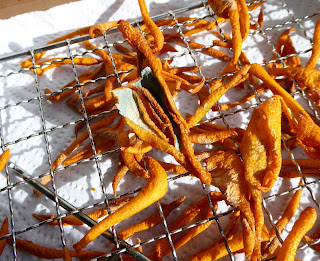The Food In Jars Mastery Challenge for the month of February is salt preserving. I made two items for this challenge - salt preserved Meyer lemons and this citrus herb salt. From my facebook feed, I'm guessing that thousands of households across the world have salt preserved lemons for the first time. I won't post a recipe here because it is a process that is easy to find and duplicate. For me, the real challenge will be making food around those salt preserved lemons. I hope to share some of the successful uses here.
I decided to try an herb salt because I have really enjoyed dry brined poultry. The flavor components in this mixture are very similar to what I use when I dry brine turkey. Making the dry brine is a bit of a production, so I thought, Why not make it and dry it and have it ready all the time?
Depending on the humidity in your home, when you make this, you may have to use your oven to help in the drying process. It has been very rainy and humid in my world, so I ended up using the oven once at the beginning of the drying and once again just to finnish it off. The mixture spent about a week in a back bedroom, near the furnace, in between. Leaving it out for a week did not reduce the flavor or aroma at all. It is wonderful!
You can use this to dry brine, by coating the meat and letting it sit in the fridge for a time. The thinner the meat, the less time it takes for the flavor to penetrate. These boneless, skinless chicken thighs were seasoned in the morning and then cooked after work. For a turkey, I will let it sit for several days. If you really coat the meat, you will want to rinse it of the excess salt and pat dry before cooking. If you sprinkle it lightly, like you would a seasoning salt, you can leave it on.
These thighs got simply pan seared, until cooked through, and served with fried cabbage. Mr. Dwayne thought it superb.
Citrus Herb Salt
1/2 cup citrus zest - I used Meyer lemon and Satsuma mandarins
3 fat cloves of garlic
1 tbsp. minced dry onion
1 cup roughly chopped parsley - I included the stems
1/4 cup fresh sage leaves
2 tbsp. fresh rosemary leaves
1 tbsp. freshly cracked black pepper
1 1/2 cups coarse Kosher salt, divided
Place everything except 1/2 cup of the salt in a blender or food processor and process until well ground and blended. Remove from the processor and stir in the 1/2 cup of salt. (My Vitamix ground this so finely, that I wanted to add a little more granulated texture back into the mix. If your food processor is not so aggressive, you can add everything at once.)
Spread the mixture, in a thin layer, on a parchment lined cookie sheet. To dry, either set in a warm, dry place until completely dry or assist the drying process by using your oven. I placed mine in the oven, at 200 degrees, for about 10 minutes, turned the oven off and left it in the oven until cool. I had to do this process twice.
If you have any of those little silicone sachets from some other food product, you can add it to the storage jar to prevent caking. This makes 2 1/2 cups of salt. I keep a small jar by my stove and the remainder in the fridge.


















